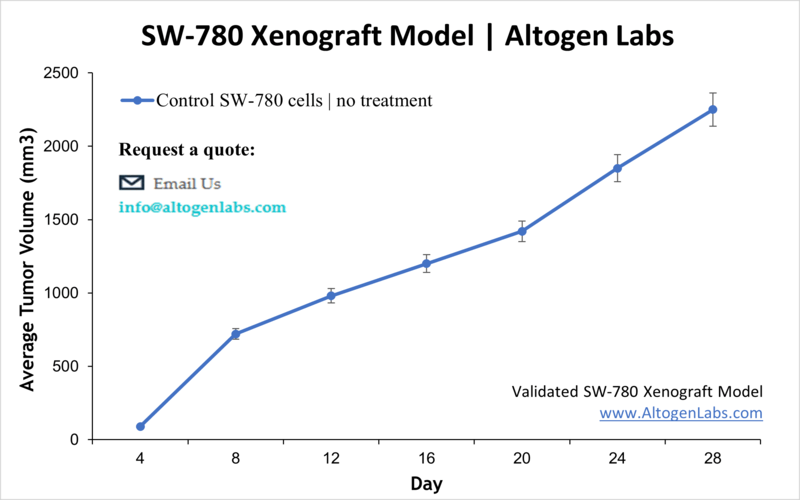
Bladder cancer typically occurs in older adults and occurs in approximately 200,000 people annually in the US. Bladder cancer is characterized by which layer the tumor affects: the inner epithelial lining, the middle muscle tissue or the outer fatty tissue, fibrous tissue or blood vessels. In 1974, A. Leibovitz established the SW780 cell line from a grade I urinary bladder transitional cell carcinoma in an 80 year old patient. The cell line has since then been used in many studies. In 2017 Luo et al. (Journal of Nutritional Biochemistry) published a study using the SW780 model for the in vitro and in vivo (xenograft) examination of Epigallocatechin-3-gallate (EGCG), a bioactive polyphenol compound found in green tea. Results demonstrated that EGCG treatment led to an NF-κB and MMP-9 mediated inhibition of bladder cancer cell proliferation and migration. John et al. (Molecular Imaging Biology, 2017) used the SW780 xenograft model to develop an auto-bioluminescent model for bladder cancer. The group used a bacterial origin lux reporter system comprised of six genes (luxCDABEfrp) to produce bioluminescence signals without the need for exogenous substrates. These in vivo imaging models can be used in pre-clinical studies. Lastly, in a 2014 Cancers study (Lee et al.) the SW-780 immunodeficient urothelial carcinoma xenograft model was used to characterize hepatocyte growth factor (HGF)/Met signaling. Results demonstrated that HGF may promote tumor growth and suppression and significant Met expression in urinary cancer models. This provides evidence for the study of Met inhibitors against bladder cancer. The SW780 cell line is used to create the CDX (Cell Line Derived Xenograft) SW780 xenograft mouse model. The SW780 xenograft model enables the study of bladder cancer treatment.
Basic Study Design
- Prior to injection, SW780 cells are maintained in exponential growth phase under aseptic conditions.
- Cells are trypsinized and cell count viability is determined using a trypan blue exclusion assay (98% of cell viability is required). SW780 cell suspension is adjusted to appropriate density.
- Each mouse is subcutaneously injected into the right flank with 106 cells in 100 µL of a Matrigel-SW780 cell suspension.
- The injection sites are palpated up to three times weekly until tumors are established to an average size of 70-120 cubic mm as measured via digital calipers.
- Animals are randomized into treatment groups. Administration of test compound is performed according to the pre-established treatment schedule.
- Mice weights are measured and recorded 3 times weekly; tumors are measured and recorded daily.
- End of study is reached when tumor size reaches 2,000 mm x mm x mm, or the predetermined size limit per approved IACUC protocol.
- Final necropsy and tissue collections are performed for appropriate downstream analysis. Tumors are excised, weighed and documented by digital imaging. Tumors and tissues can be stabilized in RNA-later, snap frozen in liquid nitrogen (LN2), or prepared for histology.
